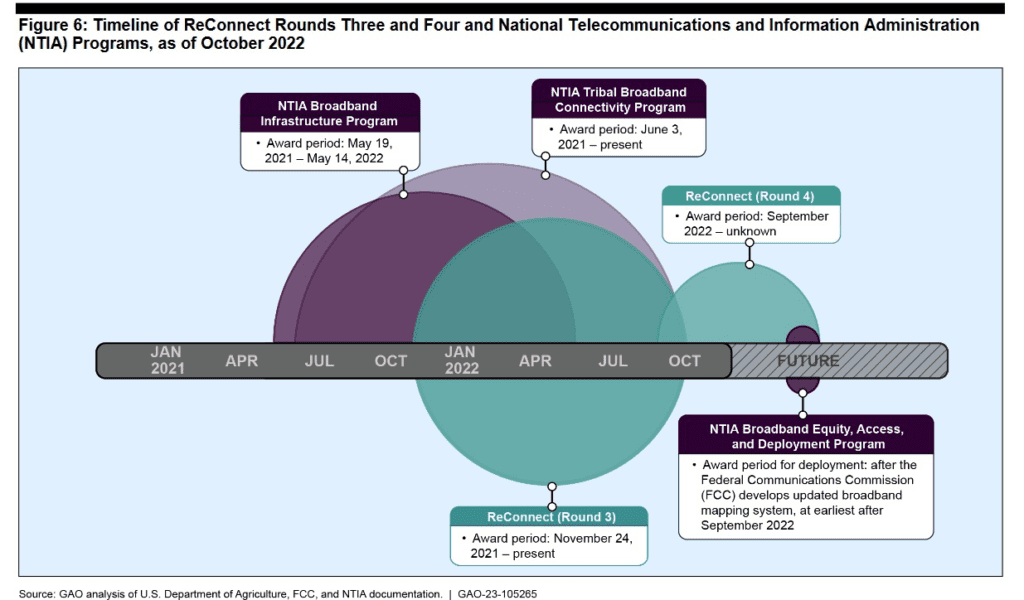GAO Warns of Possible ReConnect Overlap with Other Broadband Programs
Randy Sukow
|

The U.S. Government Accountability Office (GAO) recently took a close look that the Department of Agriculture’s ReConnect loans and grants to build rural broadband infrastructure and found room for improvement. A report finds that, while USDA has done a good job to date of avoiding funding overlaps with FCC universal service programs, there is a danger of significant overlap with programs from other agencies have established in recent years.
USDA has announced that several NRTC members won a combined $575 million in ReConnect support in the program’s third round. Also, late this year, USDA accepted applications for ReConnect Round 4, which will distribute another $1.15 billion.
The department’s rules seek to avoid funding overlaps with other programs. The first two ReConnect rounds specified how ReConnect would co-exist with the FCC’s Connect America Fund second round (CAF-II) and the Rural Digital Opportunity Fund (RDOF). GAO analysis shows that only 4 percent of the geographic areas ReConnect awardees cover overlap with CAF-II and RDOF areas. However, avoiding overlap is becoming more complicated.
“For ReConnect round three and going forward, three factors may increase the possibility that award areas overlap,” the report finds.
- In 2021, the program’s minimum speed benchmark rose to 100 Mbps downstream and 20 Mpbs upstream from 10/1. At the same time, USDA said that new ReConnect awards could overlap with previous ReConnect awards at lower speed. New ReConnect awards also could overlap with RDOF under certain circumstances.
- Two new National Telecommunications and Information Administration (NTIA) broadband programs have minimum service speeds of 25/3, which also could open up overlaps with faster ReConnect winners. While USDA has specific rules to guard against overlap with FCC programs, it does not have rules in place specific to NTIA’s programs.
- The timing of future awards by USDA, FCC and NTIA also could be a factor. “Unlike the case with ReConnect rounds one and two, USDA is deciding on ReConnect round three awards at the same time that FCC is finalizing RDOF awards and that NTIA is finalizing awards,” according to GAO. The agencies meet regularly to coordinate, but it may be difficult to detect all instances of overlap on a tight timeline.

“Because ReConnect round three awards are currently under review, we cannot yet assess the extent to which this will affect USDA’s oversight or coordination with other agencies. We will continue to monitor these issues,” GAO says.
The same report recommends that USDA set specific performance goals for ReConnect. “During the first two funding rounds, USDA used ReConnect data to support two department-wide performance goals—one on the number of new subscribers resulting from projects funded by ReConnect and other USDA telecommunications programs, and one on private investment resulting from certain USDA-funded projects,” it said.
The report also finds that ReConnect does not follow the practices in GAO’s “fraud risk framework.” Specifically, it says that USDA must designate someone to “oversee fraud risk management activities.”
GAO has released other reports in recent weeks touching on broadband issues. Broadband network construction and operation will require many thousands of workers in order to build services the federal government is supporting through its various deployment programs. The industry could support 23,000 additional workers in 2023, the year of peak funding, GAO estimates. It forecasts more new hires for the next 10 years, but at steadily reduced levels. Workers in rural areas is a particular need.
In another report, GAO looks at the implications of the growing number of internet-connected devices for automation, industrial monitoring and other internet of things (IoT) and operational technology (OT) functions. It recommends that the Departments of Energy, Health and Human Services, Homeland Security and Transportation “establish metrics” to analyze current cybersecurity and evaluate IoT/OT risks.


